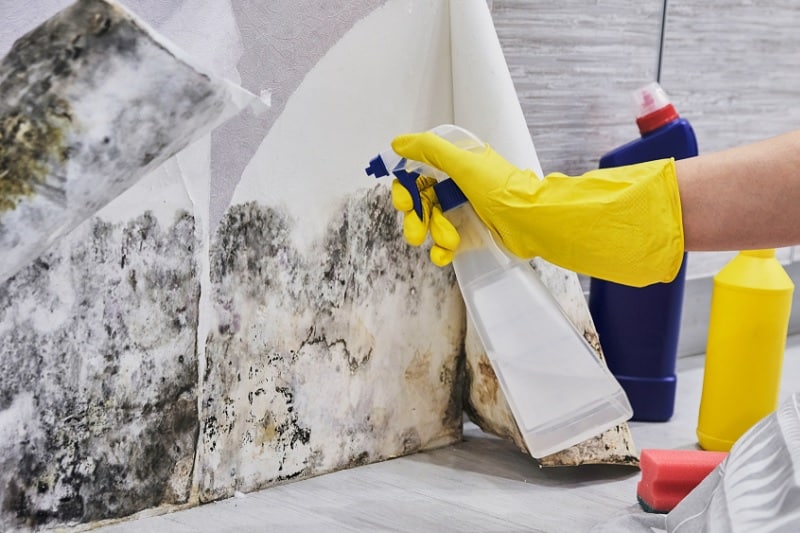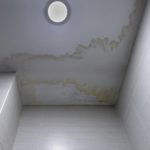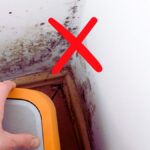Mould can quickly accumulate in damp areas of the home like the bathroom and the cellar. To stop it in its tracks and prevent it re-growing, you should use a powerful mould remover spray.
When using a chemical spray, be sure to wear protective gloves and make sure there is plenty of ventilation. Open the windows and leave them open until all of the fumes have escaped. You can also use a face mask and eye goggles for even more protection.
Here are some of the best mould remover sprays available in the UK. They are all fairly priced and can be relied on to provide results.
The Best Mould Remover Products in the UK
1. Dettol Anti-Bacterial Mould and Mildew Remover
Dettol’s Anti-Bacterial Mould and Mildew Remover uses a powerful bleach to remove mould and mildew and kill 99.9% of viruses and bacteria.
It’s good for use on stainless steel, plastics, ceramics and white grouting.
The label lists several surfaces it’s not suitable for, including wood flooring, enamel and rubber.
As with most mould removers, this spray contains some harmful chemicals so you should use protective gloves and make sure there is plenty of ventilation.
If you’re worried that it might damage the surface you’re using it on, test it on a small out-of-sight or inconspicuous spot and leave it for three minutes to check that it doesn’t damage the surface.
The spray is easy to use. You just pray on the surface at a distance of about 25 centimetres and then leave it for up to 5 minutes before wiping the surface and rinsing it clean.
This product is great at removing mildew, grime and mould and can be used on lots of different surfaces.
2. HG Mould Spray
HG Mould Spray is one of the bestselling mould remover sprays in the UK. It can be used to remove black and brown mould stains or remove algae or fungus. It’s good for cleaning the shower, the bathtub or your bathroom tiling.
Using HG Mould Spray is very straightforward. You just spray it on the surface you want to clean, leave it half an hour or so and then wipe it off. You should use gloves and keep the window open when cleaning with this spray.
In addition to removing and preventing mould, you can use HG Mould Spray for getting rid of tea and coffee stains. Always make sure you follow the instructions carefully to get the best results.
HG Mould Spray creates unpleasant fumes, so you should make sure there is plenty of ventilation when you use it. If you use it in your bedroom, open the window wide and wait until the smell has completely gone before sleeping.
This spray is very effective at removing black mould from bathroom tiles and other areas.
3. Cillit Bang Black Mould Remover
Cillit Bang Black Mould Remover comes in a spray bottle and is effective at getting rid of black mould in damp areas such as bathroom tiles, bathtubs and sinks.
You should be careful which surfaces you use this product on. The label lists surfaces you shouldn’t use it on, including treated wood floors, marble and granite.
To use Cillit Bang Black Mould Remover simply spray it on the surface you want to clean at a distance of 20 centimetres or so. You then leave it for up to 5 minutes, and then rinse it with water.
This is a very effective product, but the nozzle is poorly designed and easy to break.
4. Pro-Kleen Mould & Mildew Remover
Pro-Kleen’s concentrated mould and mildew remover spray is a great value, powerful solution.
This spray can be used to deal with all brown and black stains that are caused by mould, fungus, or algae, whether those marks are on seals in the bathroom, shower cubicles, plaster, or elsewhere.
Pro-Kleen’s formula can also help to prevent regrowth for up to six months, meaning you should not need to top up the application every few weeks.
Using Pro-Kleen’s spray is easy; simply spray onto the affected service, then leave it to sit for 10 to 20 minutes, before rinsing away with water or a sponge, no scrubbing required!
Like with many cleaning chemicals, this mould remover from Pro-Kleen can cause strong fumes and can be irritating to the eyes and skin. Always use in well-ventilated areas and wear suitable gloves.
5. Astonish Mould & Mildew Remover
Astonish Mould & Mildew Remover is designed to kill 99.9% of mould and bacteria and also prevent re-growth.
Using it is very straightforward and doesn’t involve any scrubbing. This product uses a powerful bleach to kill mould and clean surfaces in the bathroom, kitchen and elsewhere.
You simply spray it on the surface you want to clean, leave it for around 15 minutes and then wipe it off.
Since this product contains bleach, you should be careful when using it on coloured surfaces. It will clean white tiles very well but might remove the colour from paint or coloured surfaces.
If you’ve tried homemade cleaning solutions without success, something powerful like Astonish Mould & Mildew Remover could be what you need. It’s very effective at removing mould, algae and mildew.
6. Wet & Forget – Moss Mould Lichen & Algae Remover
Wet & Forget is suitable for use on outdoor areas such as patios, tarmac, paths, tennis courts, and more. You can use this formula to give a new lease of life to just about any surface that is exposed to rainfall.
Wet & Forget does not contain any bleach, and so is not as harsh as other alternatives can be. The chemical can simply be diluted (5 litres of concentrate will make 30 litres of cleaning solution) and sprayed across surfaces, with no scrubbing, rinsing, or expensive equipment needed.
Some of the ingredients in Wet & Forget will remain active after application to stop the mould coming back prematurely.
It is worth bearing in mind that this chemical from Wet & Forget can take a few days or even a couple of weeks to show true results on some surfaces.
On wooden or plastic surfaces, the results can be very quick, however, you may need to be more patient with absorbent surfaces like brick or concrete.
7. Kilrock Blast Away Mould Spray
This Blast Away Mould Spray from Kilrock is ideal for cleaning mould, mildew and algae stains from areas in your home and even outdoors.
Ideal for tiles and walls, this spray will work wonders in your bathroom, removing any signs of mould or mildew which can pose a problem in bathrooms that are difficult to ventilate.
Spray the surface which is affected by mould and leave it to work its magic for around 15 minutes (or longer if you feel it is necessary).
Make sure to wash this away thoroughly and dry the surfaces afterwards. Kilrock Blast Away should prevent mould from returning for a fair while, meaning you can enjoy a mould-free home in the mean time.
This product is quite potent and does have a strong smell, so it is important to ventilate the area you are cleaning as well as you possibly can while using this spray. Also, it is recommended that you use gloves when handling this product as it does contain bleach.
Kilrock Blast Away Mould Spray can be used on a multitude of surfaces, but as it contains bleach, do be careful when using this cleaner on painted surfaces such as walls.
What Causes Mould?
There are several causes of mould in the home. Firstly, mould forming due to excess moisture can be caused by problems with the actual structure of the building, such as leaking pipes, rain leaking in through the roof or around windows (penetrating damp), or rising damp in basements.
The other main cause of mould inside our homes is condensation. When indoor air can no longer hold moisture, condensation begins to form, particularly on cold surfaces such as windowsills, mirrors and walls.
Cooking, showering, bathing and drying washing indoors are just some of the everyday activities that increase the moisture in the air causing more condensation to form.
If there is too much condensation on a surface, mould may begin to grow that looks like a small group of black dots.
Tips for Preventing Mould
Mould can cause many problems in our homes and can also cause a potentially serious health risk, particularly for those suffering from allergies or asthma.
Even if you don’t suffer from allergies, mould can cause irritation to your eyes, skin, throat, nose and lungs.
Mould can also seriously damage your property, resulting in expensive repairs if left untreated.
Luckily there is plenty you can do to prevent mould and to protect yourself and your home.
Reduce moisture
Reducing moisture in your home is one of the easiest ways to prevent mould forming. It’s easy to make simple changes to do this, for example:
- Dry clothes outside whenever possible and avoid drying them on radiators if you have to dry them indoors.
- Keep the lids on pans and use an extractor fan when cooking.
- Vent your tumble dryer outside if you can.
- Open bedroom windows as much as possible, even in winter.
- If any of your household appliances have drip trays, make sure they are emptied regularly.
- Dry wet areas immediately. This applies to both small everyday spillages, and to more serious problems such as wet floors caused by a leak.
You might also want to consider purchasing a dehumidifier to reduce the level of humidity in your home, particularly if you need to dry clothes inside often or if you struggle to reduce the moisture in your home using the methods above.
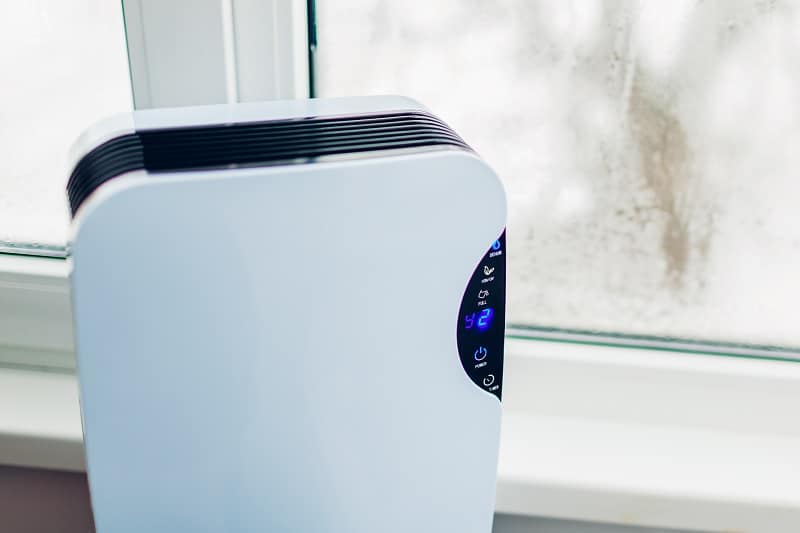
Improve ventilation
Improving ventilation is another important step to help prevent mould from forming in your home.
It’s a good idea to ventilate rooms regularly and to open doors between rooms, to allow air to circulate around your home.
However, if you’re cooking, showering, bathing or doing laundry, you’ll need to close the door of the room that you’re in and open a window.
It may be worth getting an extractor fan installed in the bathroom, to run whenever you’re in the room to reduce condensation, and if possible let the fan run for 30 minutes after a bath or shower.
Identify and repair structural problems
As mentioned previously, some damp and mould problems are caused by structural problems, for example, leaks in a roof, around a window or in pipes, or even rising damp.
Even if repairs seem expensive initially, fixing problems sooner rather than later will prevent mould developing.
Many leaks in homes are caused by problems with faulty roof gutters, so it’s worth getting these checked regularly too.
Monitor moisture levels in your home
Moisture meters (hygrometers) can be bought easily and cheaply from hardware shops or online, and are a good way to monitor and control the moisture levels in your home and detect potential problem areas. Aim to keep humidity levels below 60% if possible.
Keep your home warm
If you want to prevent mould, you need to keep your home as warm, particularly in colder weather. Cold air can’t hold moisture as well as warm air, and therefore condenses on cold surfaces and mould begins to grow.
Installing loft and cavity wall insulation and draught-proofing windows and exterior doors can help keep your home warmer and means reduced energy bills too.
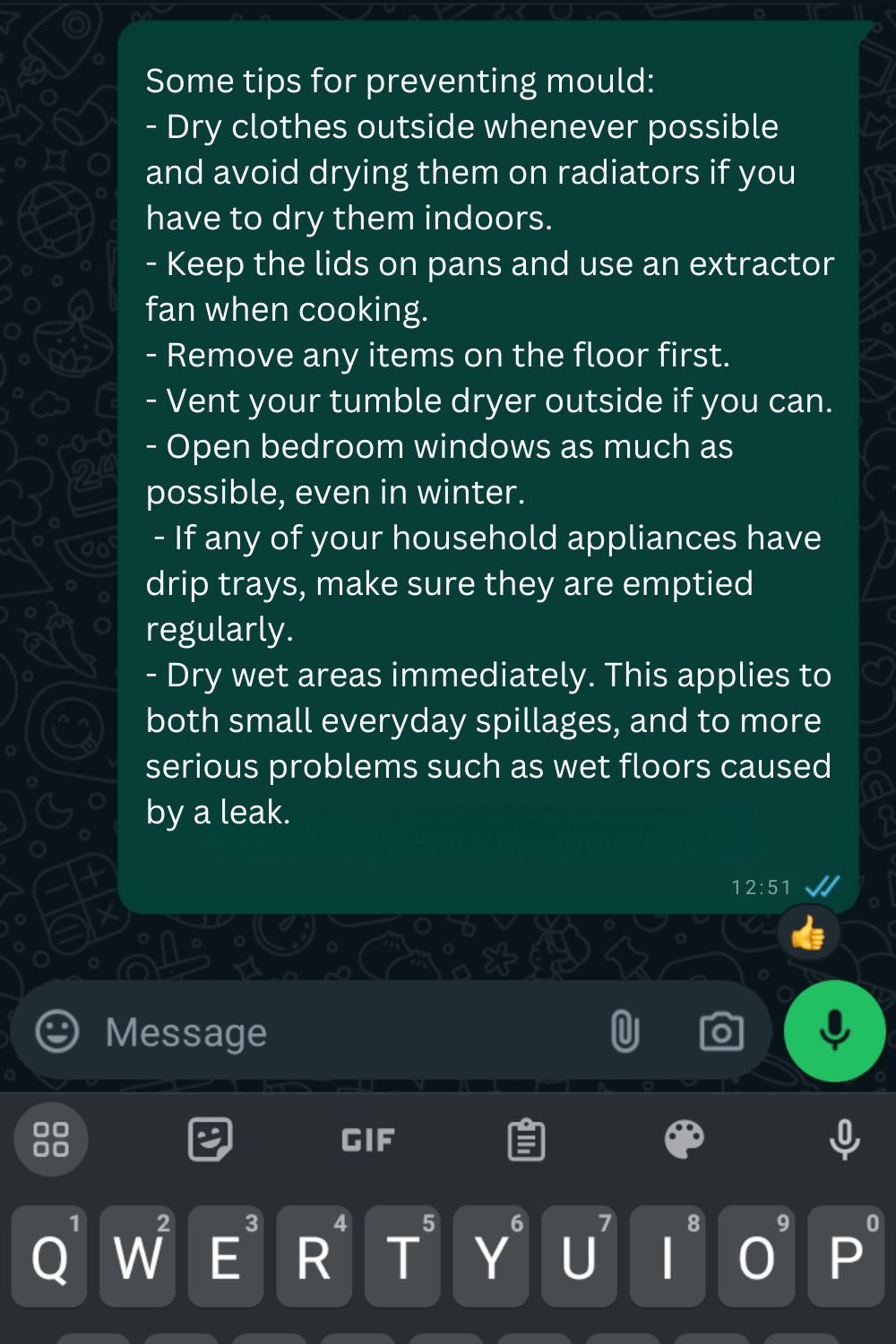
How to Reduce Mould in the Bathroom
Mould can be a big problem in bathrooms and other areas that have a damp atmosphere. Mould is a type of fungus that thrives in a warm environment where the relative humidity is 70% or higher.
Fertile mould produces spores that are carried around in the air and so spread further.
Mould appears as a black deposit on ceiling and walls, and not only looks unsightly and has an unpleasant smell but also causes damage to walls, floors and ceilings as well as giving rise to breathing difficulties for those who have respiratory problems. So, it’s important you prevent or eliminate it.
As with most things, prevention is better than cure, so trying to avoid mould occurring will always be preferable to attempting to eradicate it once you’ve got it.
Since mould thrives in damp and warm conditions, a bathroom is a perfect environment for it to flourish. Your aim, therefore, is to change these conditions and so prevent the build-up of mould.
1. Let moisture escape
The most obvious way to reduce the amount of moisture is to remove it from the bathroom. That can be done by opening a window while showering or bathing so that steam can go outside naturally.
In cold winter months, this may not be practical and the best alternative is an extractor fan that will remove the worst of the steam. An extractor fan is also essential for bathrooms that do not have windows, such as those in flats which may not have outside walls.
Run the extractor while showering or bathing and up to thirty minutes afterwards to be most effective, ensuring the bathroom door is closed to prevent the moist air circulating throughout the house.
As well as helping to reduce the level of moisture, adequate ventilation is also good for health generally.
2. Reduce condensation
Moisture in the bathroom is a bigger problem when it condenses as water on cold surfaces, which can be alleviated by keeping the room well heated.
Effective insulation will certainly help here while air conditioning will also purify the air and a good dehumidifier will remove moisture from the air, both in the bathroom and throughout the rest of the house. Aim for humidity levels of no more than 50%.
3. Remove excess moisture
Preventing a build-up of moisture is also helped by removing excess water at the outset.
Always squeegee the shower dry when you’ve finished so the excess water drains away rather than remaining on the walls. Fix any drips or leaks since they will otherwise constantly add to the room’s moisture.
Don’t leave wet sponges and cloths in the shower or bath since they will add to the level of moisture in the atmosphere.
If you can’t put them in a sealed container or cupboard, at least squeeze them out thoroughly so they’re relatively dry.
4. Keep the bathroom clean
It’s also important to keep the room as clean as possible since dust is a source of food for the mould and the mould spores travel through the air.
Dust at least weekly with a slightly damp cloth and clean all surfaces with a general-purpose cleaner, drying thoroughly to reduce moisture.
Also, wash any mats and shower curtains once a week and ensure they’re completely dry before putting them back.
Lastly, mould thrives in dark areas as well as those that are warm and damp. So where possible, make sure your bathroom is well-lit and don’t leave the blinds down throughout the day.
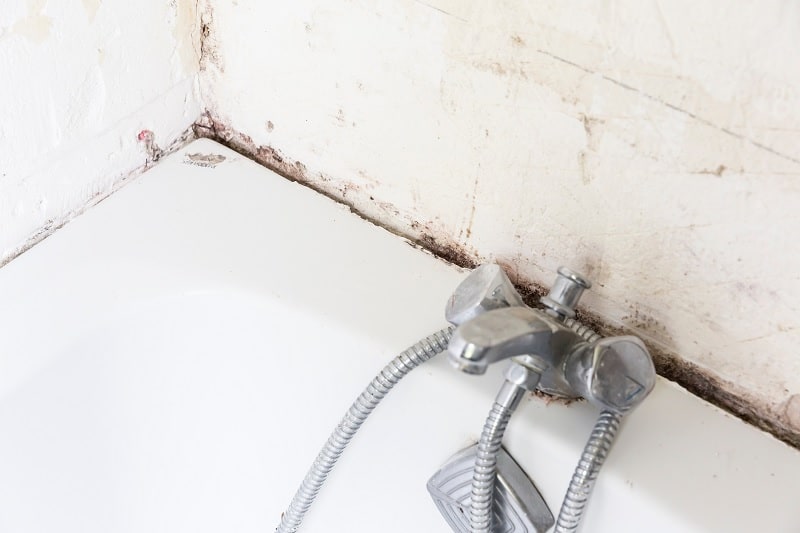
Conclusion
If we had to pick just one mould remover product to recommend, it would be Dettol Anti-Bacterial Mould and Mildew Remover. It’s easy to use and will kill bacteria as well as removing mould.
It’s suitable for most surfaces including stainless steel, ceramics, plastics and white grouting. However, it’s not suitable for enamel, rubber or wood.

In The Wash is your guide to the best laundry and cleaning products, tips and tricks. Our mission is to solve the UK’s cleaning and laundry dilemmas!
